Chapter II :Quality of the Environment in Japan 1998
Chapter II: Development of Local Communities with "Sound Material Cycle" and "Coexistence of Nature and Human Being", from the Viewpoint of Japan's Land Use
2. Measures taken regarding different spheres based on the natural factors that form Japan's land
Measures taken with consideration of eco-spheres
Here we define areas needed for the conservation of ecosystems as 'eco-spheres. ' Eco-spheres can take various forms according to the types of resident fauna and flora as well as that of the ecosystem. Eco-spheres exist on various scales ranging from the regional, the nationwide to the global scale. Below are some environmental measures for eco-sphere protection.
Land classification for biodiversity conservation and important information about each region
In December 1997 the Environment Agency established a plan of 'Land Classification for Biodiversity Conservation and Important Information About Each Region.' The purpose of this plan is to achieve a general understanding of the biological characteristics of areas as the basis of biodiversity conservation and to consider goals for a conservation and management system.
Land Classifications for Biodiversity Conservation and Information on
Important Areas about Each Region (Provisional)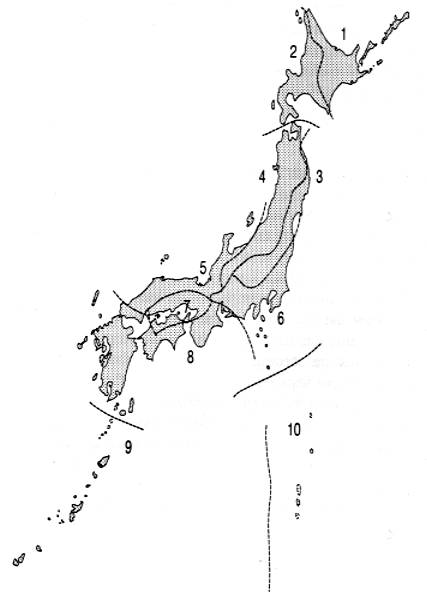
Source: Environment Agency
Conservation of migratory birds and their habitats
Japan's grasslands, wetlands and tidal zones provide important habitats for migratory birds.
The Asian Wetland Bureau (AWB) and the International Waterfowl and Wetlands Research Bureau, Japan (IWRB), drew up the 'Asia-Pacific Migratory Waterbird Conservation Strategy.' Based on this strategy the 'East Asian-Australian Shorebird Reserve Network' was established in 1996. This network embraces 24 wetlands in nine countries including two wetlands in Japan. Since 1988 the Environment Agency has continuously conducted observational surveys of waterfowl in their major habitats all over the country. The 'Inventory of wetlands for shorebirds' was published based on the results of these surveys up to 1996. Maximums of over 1,000 migratory birds were observed in 19 areas. These areas included the estuary of the Shonai, Shin and Nikko rivers, where the Fujimae tidal flats are located, and Lake Komuke. As a result of this survey some areas have been proved to be important habitats for shorebirds, with large numbers of birds or of species observed.
Essential habitats for migratory birds such as wetlands should be considered to be eco-spheres and should be conserved in entirety with the birds acting as flagship species.
The Maximum Number of Waterfowl Recorded
in Fixed Point Observation between 1988 and 1998 (Over 1,000 birds)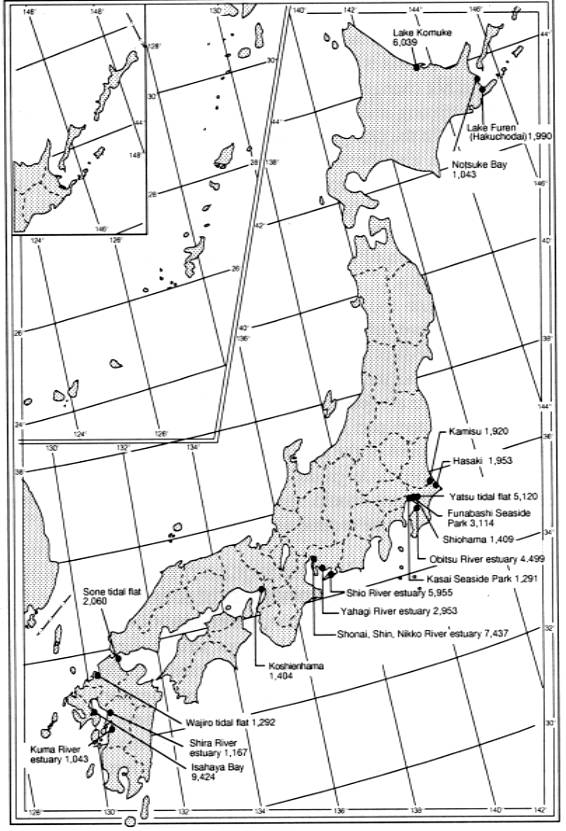
Source: Environment Agency
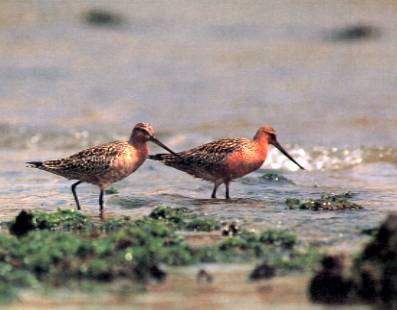
The bar-tailed godwit migrates from Australia to Siberia stopping over at tidal flats in Japan
Global forests that sustain the earth
Forests perform various functions fixing greenhouse gases, conserving biodiversity, producing timber, preserving land and providing scenery.
Forest fires in Indonesia
The forest fires which started in Indonesia around June 1997 spread with the assistance of droughts caused by El Nino, destroying a vast area of forests and wildlife habitat. Furthermore the smoke from the fires caused air pollution in large areas and released huge amounts of greenhouse gases such as carbon dioxide and methyl bromide.
In Indonesia large-scale forest fires have occurred frequently since the 1980s. This is because rainforest has been divided and opened up and the land has dried up due to logging and cultivation. As a consequence of these activities there has been an expansion in areas vulnerable to fires.
Situation of forests in Siberia and the Far East
In recent years not only tropical forests but also forests in Canada and Russia have come under threat. Russian forests account for 22% of the world's forested area and 21% of the world's total forest deposit. The forest area in Russia is slightly increasing, but the forest deposit has not changed. The deposit of mature forest is rapidly decreasing and the overall quality of forests is deteriorating. In the non-permafrost areas in the southern part of Siberia and the Russian Far East, forests have been exploited without proper management approaches, for example, plantation style management. This has occurred since the collapse of the Soviet Union, and is causing degradation of the forests and the expansion of logging operations.
In this region too, forest fires occur frequently. In bad years over two million ha of forests are destroyed by fire. Again these fires are thought mostly to result from human activities as the conflagrations seem to initiate in areas where there are felled and dried out trees. If forests in the north-eastern part of Siberia and the Far East are lost, a great amount of the greenhouse gas methane that is currently trapped underground in the permafrost would be released. Methane would also be emitted from the wetlands that would be created after the permafrost was gone.
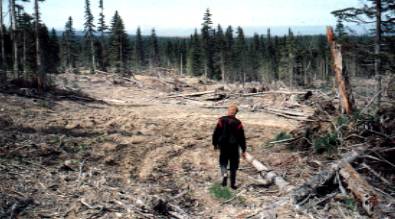
Logged land in Sakhalin (after some years)
Photo: Courtesy of Friends of the Earth, Japan
Future plans for eco-sphere protection
There are many kinds of eco-spheres from those of a small scale small-scale, such as biotopes, to topographical eco-spheres such as watersheds and peninsulas. Elements of some ecospheres, such as forests or migratory birds span national borders. It is currently necessary to seek to develop a pattern of human activities that can be harmonized to coexist with the mechanisms of nature, on a level beyond that of established administrative borders and economic systems.
Measures taken with consideration of watershed sphere
Here "watershed sphere" is defined as a particular regional unit linked to watersheds including flood plains. The natural factors which go to make up a watershed sphere, such as forests, water, soil, and fauna and flora, all enjoy interdependent relations within the watershed sphere.
Forest as a partner of the sea
Fishermen in Miyagi Prefecture who noted some changes in the sea discovered that one contributing factor was the worsening environment of the region's rivers and watersheds. They also discovered the close relationships that exist between forests, rivers, the sea and plants and animals. In order to improve the watershed environment, they have started community exchange activities such as plantation activities in the upstream areas. Similar activities are starting in other parts of the country. This movement testifies to the necessity of considering and dealing with the environment as a whole watershed sphere, i.e. taking a comprehensive view of the mechanisms of nature without limiting the view of the whole to just constituent parts.
Red soil runoff in Okinawa In Okinawa
Prefecture environmental pollution of drinking water and extinction of coral reefs has been caused by red soil released from the land as a result of changes in land utilisation in the watershed area. Red soil runoff occurs principally because of various public works projects such as construction of agricultural land and roads. Construction of tourism facilities by commercial enterprises has also been a contributing factor.
From Source to Impact of Red Soil Runoff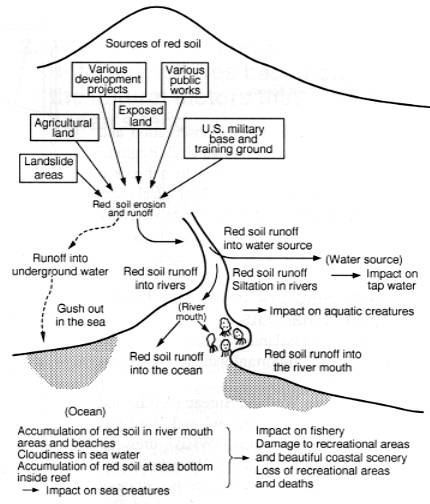
Source: Environment Agency
Measures for conservation of watersheds environment
As explained above, measures for the conservation of watershed spheres need to be taken by treating the watershed as a whole unit, but, in practice, various administrative measures are carried out on each issue separately by different administrative offices. However, recently there have been some attempts to coordinate measures undertaken by different administrative offices. A case in point is the establishment of "the water environmental guideline of watersheds in Hyogo Prefecture." "The Katsura and Sagami river basin agenda" also furnishes an example of recent attempts at collaboration between citizens, companies and administrations in both upper and lower riverine areas, to promote the environmental conservation of their watersheds and the development of their local communities.
Flood control in the United States
Thanks to the development of civil engineering technologies in modern times, the number of flood disasters in the US has been successfully reduced through the construction of dams and levees. At the same time, however, it is said that settlement in flood plains has been promoted and the risk of floods on a greater scale has become higher. Therefore, for the last 30 years the US has also taken measures to prevent flood damages by restricting urban development in flood plains. For instance, the US Army Corps of Engineers, which is one of the departments in charge of dam construction, is also promoting the reinforcement of the water retention function of upper riverine zones in addition to the construction of dams and levees. Furthermore, in May 1994, the President of the Department of the Interior's Reclamation Bureau, Mr. Beard, stated, "The period of dam construction in the US has come to an end." In addition, some existing dams are being demolished or sluices are being opened to allow water through dams. This is expected to contribute to the recovery of natural ecosystems.